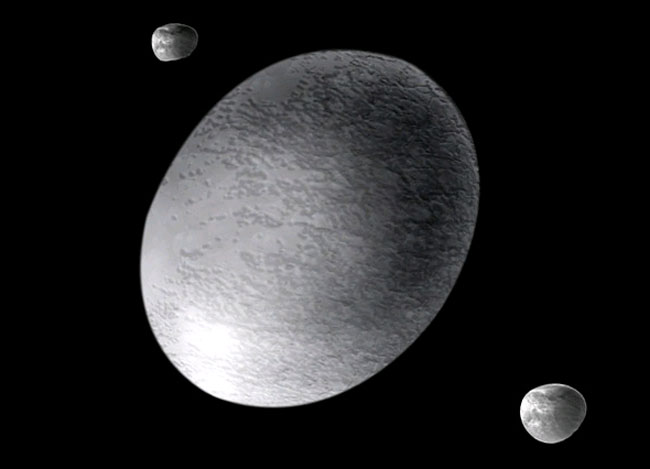The dwarf planet 2003 EL61 is henceforth named after the Hawaiian goddess of fertility * Haumea has two moons and their names are the names of the children born to Haumea in Hawaiian mythology - from parts of her body * The moons are rocks that were blown from the dwarf planet during a collision with another body

The World Astronomical Union has announced the name of a new dwarf planet that joins the four known dwarf planets in the solar system: Ceres, Pluto, Eris andMaki-maki. As you remember, Pluto lost its status as a planet and was reclassified as a dwarf planet in 2006 following the discovery of Eris, which is larger than it, which led tostruggle Huge among the astronomers who believed that Eris and the other objects of a similar size deserve the status of a planet, as Pluto was awarded after its discovery in 1930.
The bone was previously known as 2003 EL61, and is now known as Haumea after the goddess of birth and fertility in Native Hawaiian mythology. The name was decided by members of a committee of the World Astronomical Union responsible for naming small bodies in the solar system, and the working group for nomenclature of bodies in the solar system.
The discovery of the body shaped like an (American) football was first announced in 2005. It was discovered by a group of researchers led by Jose-Luiz Ortiz from the Sierra Nevada Observatory in Spain, and by the team of Mike Brown from Caltech, who is also behind the discovery of the dwarf planet Eris. Brown and his colleagues first observed the new dwarf planet in December 2004, shortly after Christmas, leading them to call it Santa, the Bone Waves wrote in their blog this week. The new name was suggested by a co-discoverer, David Rabinovitch of Yale University, who claimed that it was particularly appropriate because the Umayyad goddess also represents bedrock and observations of the celestial body showed that it is composed almost entirely of rock and covered in a crust of almost pure snow. Brown added.
Omia is similar in diameter to Pluto, but it is much thinner and contains only about a third of Pluto's mass. The scientists believe that the long and narrow shape of the Omiya is due to its rapid rotation - it rotates around its axis every four hours. Huma is now 50 AU from the Sun, and can approach as close as 35 AU, like most rocky trans-Neptunian bodies.
Two accompanying objects were also discovered near the Omiya, apparently rocks that were torn from it when a large body hit the dwarf planet. These two moons were also named - Hi'iaka and Namaka, after the names of the Umami's two children in Hawaiian mythology. In the story, her children were created from parts of her body, just as Humea's moons were born from it.
- To the page about Humea on Mike Brown's website
- A video describing the Umayya's rotation around its axis

10 תגובות
I am in 2011 and in a few weeks it will be 2012 and I just read it the other day
Thank you internet and of course Avi Bolizovsky thank you if you are my life
But thank you very much.
Something is not clear here.
On the one hand it is written that David Rabinowitz (Rabinowitz's son)
Says that according to Umayyad observations, most of it is made of rock
and covered with chrome of pure ice". The use of the word "chrome" creates the impression that the layer of ice is thin in relation to the radius and therefore, its specific gravity should be close to that of the rock of which it is mostly composed. On the other hand, it is claimed that relative to Pluto its specific gravity is only about a third (because whose dimensions are similar to those of Pluto).
:!All respect!Absolute absorption.Thanks GBY :)))))LLLBOY
Hugin and Monin.. of Odin.. WTF??? Wow, Cannon A. I have seen excavations like this since the First World War
Celestial meiosis:/subatomic meiosis:/plutonic meiosis./and more..
And of course- what we see here is this: "Santa-Clausian miuse…………..: Haum-ya??
Hugin: In a comprehensive classical muse.
Thanks, corrected.
It should be Namaka, and not Nakama as written in the article.
Plasticine I thought it was forbidden to write on Saturday.
Another decisive proof of the greatness of the Creator's actions